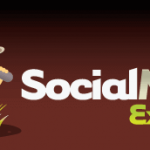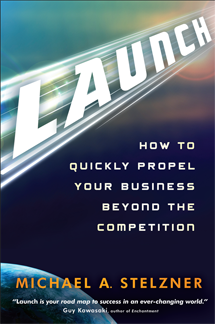Mike Stelzner, founder of Social Media Examiner, visited LinkedOC last week to share some great incites and information about his new book, Launch.
Think of Business as a Rocketship
Mike Stelzner began Social Media Examiner in October 2009 and, in less than two years, it’s become one of the top business blogs, with a subscription base of over 80,000. Being an “overnight success” himself, he advised thinking of business as a rockship as it needs to be navigated, with the goal being to reach new heights; somewhere beyond where you are today.
To achieve this, you need people: peers, perspective customers, etc. Like space travel, everything is moving in orbit: industries advance, ideas expand, product support moves and customers move on.
With change comes questions about how to proceed. The best way to move forward in a continually-evolving world is to provide things that will never become outdated: incite, recommendations, etc. People don’t want products and they don’t want to be sold.
Mike provided the example of trying to brush the hair of his young daughters; they don’t sit still. You can’t switch angles and keep trying to brush a child’s hair, but they’ll continue moving as well and the attempts won’t be successful. We have to stop treating people like kids, and instead, change the entire approach rather than the angle of the “wrong” approach.
Marketing
Mike quoted the definition of marketing per the American Marketing Association:

The question, then, for markers is, “How can I attain quality leads, gain trust, break through the noise, etc. etc.?”
The answer? Trial and Error.
Focus on People
Stelzner placed huge emphasis on focusing on people, and offerings things for FREE. He says to help solve problems at no cost as when you help them with smaller issues, they’ll develop trust in you, and they’ll then consult you for bigger issues.
The enabler is content — it has unlimited scalability. Peoples’ desires don’t change. When you give something away as a gift, you trigger the question, “how much more (would they be willing to gain from you)?
While this may seem counter-intuitive, Stelzner says to give away all your secrets — no one can tell it like you can.
Don’t focus on yourself, products or services. Shine the spotlight on others: outside experts, successful peers, etc. When you lift other people up, they’ll lift you up! —
Rule of Reciprocity
Reciprocity if often abused by marketers (car salesmen, for example). When he says give something away for free, Mike really means to offer it as a gift, not a “trick” to automatically anticipate something in return.
A true gift will make you valuable. What if you received a wedding gift that was an ad? You’d be turned off to it.
“Caging Marketing”: When someone asks how they can help you, but then goes to explain what they’d like from you in return. It’s going for the quick kill rather than waiting it out a bit for better rewards.
“The Elevation Principle”
Form great content! HubSpot (a site I personally love and read frequently), for example, markets themselves entirely through content. They don’t advertise, they don’t even have their logo on some of their affiliated sites. They offer everything for free, and they get around 25,000 leads/month.
Create content that helps your readers make decisions: review books, products, events, and provide your opinions. Do case studies: share successful stories of businesses in your industry. Reports based on surveys are also highly effective. Survey people and create a free report on the findings. Survey results tend to be viral and they have a long SEO/shelf life. Contests are another good way to build relationships with others.
Show problem > solution > results.
Primary Fuel vs. Nuclear Fuel
Primary Fuel is regularly-produced content. It keeps you moving, is core to growth, draws people to you, establishes trust and brings people back.
Nuclear Fuel is more difficult to produce, used less frequently, has bigger impact, draws people in, has a long tail, gets you noticed, etc.
How do you plan on using these tips to LAUNCH your business?








Nice recap, Debbie! I feel like I was there 😉
Great overview. Clearly you were paying attention to what I said 🙂
Thanks for reading and commenting, Mike! Looking forward to reading the book.
Thanks for the comment, Amber! Glad you enjoyed the recap.